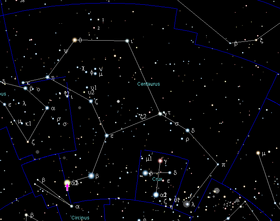Observation

To the naked eye, Alpha Centauri AB appears to be a single star, the brightest in the southern constellation of Centaurus. Their apparent angular separation varies over about 80 years between 2 and 22 arcsec (the naked eye has a resolution of 60 arcsec), but through much of the orbit, both are easily resolved in binoculars or small telescopes. At −0.27 apparent magnitude (combined for A and B magnitudes), Alpha Centauri is fainter only than Sirius and Canopus. It is the outer star of The Pointers or The Southern Pointers, so called because the line through Beta Centauri (Hadar/Agena), some 4.5° west, points to the constellation Crux—the Southern Cross. The Pointers easily distinguish the true Southern Cross from the fainter asterism known as the False Cross.
South of about 29° S latitude, Alpha Centauri is circumpolar and never sets below the horizon.note North of about 29° N latitude, Alpha Centauri never rises. Alpha Centauri lies close to the southern horizon when viewed from the 29° N latitude to the equator (close to Hermosillo, Chihuahua City in Mexico, Galveston, Texas, Ocala, Florida and Lanzarote, the Canary Islands of Spain), but only for a short time around its culmination. The star culminates each year at local midnight on 24 April and at local 9 p.m. on 8 June.
As seen from Earth, Proxima Centauri is 2.2° southwest from Alpha Centauri AB, about four times the angular diameter of the Moon. Proxima Centauri appears as a deep-red star of a typical apparent magnitude of 11.1 in a sparsely populated star field, requiring moderately sized telescopes to be seen. Listed as V645 Cen in the General Catalogue of Variable Stars Version 4.2, this UV Ceti-type flare star can unexpectedly brighten rapidly by as much as 0.6 magnitudes at visual wavelengths, then fade after only a few minutes. Some amateur and professional astronomers regularly monitor for outbursts using either optical or radio telescopes. In August 2015, the largest recorded flares of the star occurred, with the star becoming 8.3 times brighter than normal on 13 August, in the B band (blue light region).
Alpha Centauri is inside the G-cloud, and its nearest known system is the binary brown dwarf system Luhman 16 at 3.6 ly (1.1 pc).
Comments
Post a Comment